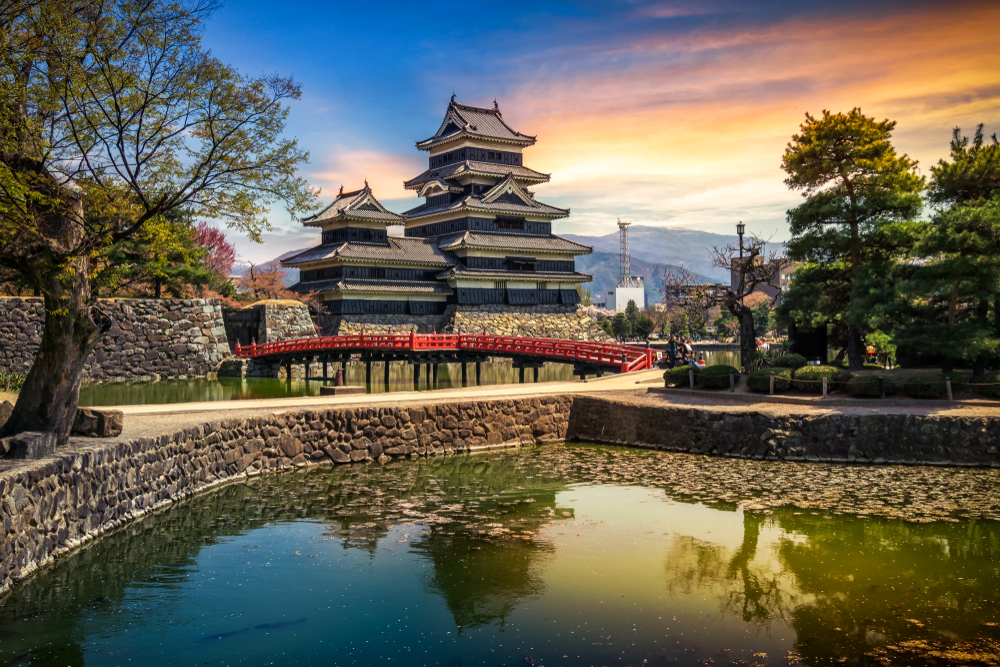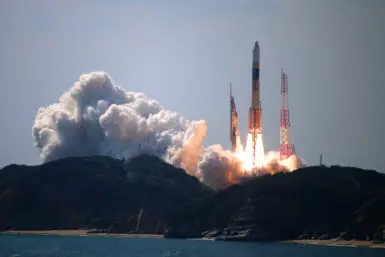The picturesque castle-town of Matsumoto offers a range of attractions, culture and events. Matsumoto Castle, completed in 1594, is Japan’s oldest existing castle and is perhaps the first thing you’ll think of when heading to the mountains, and though the city and its surrounds have much more to offer, it seems the obvious place to start any guide to the city.
In the springtime, the lush grounds at the castle’s base and snowcapped peaks in the distance make for a striking scene. With its glossy black floors and thick pillars, the castle is as dramatic inside as it is out (the castle’s elegant pitch-black walls and hilltop perch earned it the nickname crow castle.)
The exhibits of historical artifacts, weapons, and armor from the samurai era convey the feeling of a time immortalized in Kurosawa films and samurai dramas.
Surrounded by the thick, cool castle walls, climbing the steep stairways designed to hinder attackers, it is easy to imagine being in an era when buildings were made to ward off armies rather than the cold. The view from the top floor, however, almost makes one forget that this was built to watch for invaders rather than take in the crisp natural beauty of the surrounding mountains.
This natural beauty is one of the main draws for Matsumoto’s many visitors. In the warmer months, Matsumoto is an excellent base to go hiking or camping in Kamikochi, one of Japan’s most pristine mountain areas.
The nearby Norikurakogen highlands also make for a perfect day-trip from Matsumoto. Ranging from 1200 to 1800 meters, Norikurakogen offers excellent hiking in the summer, a pallet of autumn colours in the cooler months, snowboarding and skiing in winter and snow-wall walking in May and June.
The less outdoorsy can easily while away a day wandering Matsumoto’s historic downtown. On Nakamachi and Nawate Streets, old private warehouses remodelled into shops selling Matsumoto lacquerware nestle between modern cafes and restaurants.
Narrow alleys lined with food stalls and curio shops open to wide, sunny boulevards. In between wandering, shopping and snacking art lovers should stop by the Matsumoto City Museum of Art. Best known for hosting a number of Yayoi Kusama’s works, including her sculpture Maboroshino Hana (Illusion of Splendor), the museum has a comprehensive collection of works by the many other artists who hail from the region.
With a little timing and luck, visitors can also see Matsumoto transformed by one of its many festivals. The Fukashi Jinja festival (July 24-25) and Susukigawa Jinja festival (May 4-5) are especially impressive, with giant floats of Shinto deities paraded around town for two days straight.
But even with everything to do in the area, Nagano and Matsumoto are the kind of towns that ask us to slow down, to breathe the crisp mountain air, and to reconsider the hectic pace we all too often take as normal here in Tokyo. After a visit to Nagano and Matsumoto, the train ride back to the big city comes all too soon. But there is comfort knowing that these two cities nestled in the mountains are only a short trip away
Top 5 things to do in Matsumoto:
Matsumoto Castle:
The reason many visitors stop in Matsumoto is not the only thing that makes them stay, but the black and white behemoth sitting in the centre of the city sure earns its reputation as the premier castle in Japan.
There are many reasons the building is officially designated a National Treasure – not least of all its over 400 years of history (construction started in 1592) – but even before heading inside to the steep stairs and low ceilings that take you past displays of armor and weapons from the Sengoku period, the first thing you will notice is its impressive scale. Head there in April and you’ll be able to enjoy the cherry blossom lined avenues that surround its moat.
Mountain Views:
Though it is 40km to the south west of the city, Mount Norikura, one of only 21 mountains in Japan that stand at over 3,000m, is clearly visible from the centre of Matsumoto city. It stands at 3,026m and while it isn’t as tall as nearby Okuhotaka (Japan’s 3rd highest at 3,190m) it is known to be relatively easy to climb in summer.
The mountains that surround the city certainly inspire your inner climber and in different light at different times of day will either draw you towards them or frame your view of the city in a spectacular way. Buena Vista’s 14th floor restaurant is a great place to check out that view.
Matsumoto City Museum of Art:
Artist Yayoi Kusama, who recently turned 83, was born in Matsumoto and this museum, among other things, celebrates her work and aims to take you inside her world. You’ll perhaps be familiar with Kusama’s work and the polka-dots and spots that are ever-present throughout it, but it will be a sculpture entitled “The Visionary Flowers” – its wild form taking over the outside of the museum – which will invite you inside for more.
Head to Kamikochi:
One of the most scenic mountainous spots in Japan, Kamikochi is just a 90-minute bus journey from Matsumoto. Make a day-trip of it and you’ll be able to take in Kappa Bashi – the wooden suspension bridge named after a mythical creature that has become the symbol of the area.
Kamikochi is both the starting point for hikers who flock to the area and a great spot for exploring in its own right. Thick forests cover the area, which is seismically active – and as you’ll know, that means one thing: fantastic onsen opportunities.
Nawate Street:
Hop through the crowds to Nawate Dori and you’ll see frogs abounding throughout – though we’re not sure why… It was apparently Tokyo University of Art students who created a fiberglass sculpture of the creature at the entrance, but that’s not the last of the amphibian fun, which has become something of a theme…
The street is essentially an extension of the castle grounds and has various shops at which to get souvenirs or snacks – enjoy them while people watching near Yohashira shrine for the full experience.
Nagano City
Long before it gained international fame for hosting the 1998 Winter Olympics, long before skiers from Tokyo took to the nearby slopes, Nagano was a city of temples. For thirteen centuries pilgrims have come to Nagano to pray, be blessed, and enjoy. And thanks to the Nagano Shinkansen, what was once an arduous trek is now just a short hour and a half ride from central Tokyo.
Just 2km from the station, Zenkoji is the heart of the city. Founded as a non-denominational temple in the 7th century, Zenkoji is now as welcoming of tourists as it is pilgrims. Approaching from the station, the street is lined with traditional wooden houses and shops tempting visitors with everything from good luck charms and cell-phone trinkets to rice crackers and maccha ice cream. But the real treat is the temple itself.
Looking up at the intricately carved eaves of Zenkoji’s main building, the Hondo, it is easy to see why this, one of Japan’s largest wooden structures, is a designated national treasure. It may not tower as high as the skyscrapers of Tokyo, but it makes one feel small in a way that the metropolis’ forest of steel, concrete, and glass fails to match. In February, the temple trades its serene beauty for a more stunning look when it is lit up in five colors throughout the evening.
Togakushi Jinja, Nagano’s main Shinto Shrine, offers a different take on the area’s spiritual observances. Known as one of Japan’s power spots, the shrine draws visitors from all over the country. Even skeptics can find a sense of peace in the natural beauty of Okusha, an avenue lined with old Japanese cedars leading to the shrine.
This avenue is said to bring luck and good harvests to those who visit. But even pilgrims of old needed fuel for the body as much as for the soul. The specialty here is Togakushi soba. Since the Heian era, visitors to Togakushi Jinja have been eating this local take on Japan’s ubiquitous buckwheat noodles. Reputedly some of Japan’s finest soba, Togakushi noodles are made from locally grown buckwheat, immediately boiled, and then immersed in cold, crystal-clear water running from the Togakushi Mountains.
The streets surrounding Togokushi Jinja are home to some 30 soba shops serving the traditional small portions of Togakushi soba known as “bocchi-mori.” The dish is so popular that there is even a Togakushi Soba Museum (link, Japanese), offering soba-making workshops to those with culinary inclinations.
Written by Robert Morel and Matthew Holmes
Image: Travel mania / Shutterstock.com









